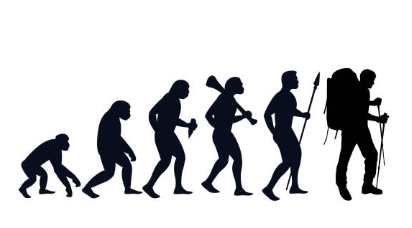How Has the Human Spine Changed Through Evolution?
 The spine has undergone significant changes through the course of human evolution, reflecting adaptations to various lifestyles and environments. Much of this is primarily driven by the transition from quadrupedalism (walking on four limbs) to bipedalism (walking on two legs).
The spine has undergone significant changes through the course of human evolution, reflecting adaptations to various lifestyles and environments. Much of this is primarily driven by the transition from quadrupedalism (walking on four limbs) to bipedalism (walking on two legs).
This adaptation, of course, has had profound implications for human development, including aspects of childbirth, organ arrangement, and even brain evolution due to changes in blood flow patterns.
Key evolutionary changes in the human spine include:
The following evolutionary changes in the spine are key factors in the ability we have to walk upright on two legs.
1. Curvature: One of the most notable changes is the development of a distinct S-shaped spinal curve in humans. In quadrupedal primates, the spine is more C-shaped. The S-shape in humans helps to maintain balance and stability in an upright position, distributing weight over the hips and legs. This helps to absorb shock during walking and running.
2. Lumbar Vertebrae: The lumbar region of the spine has become shorter and broader compared to our primate ancestors. And the number and size of lumbar vertebrae have changed. Humans typically have five lumbar vertebrae, which are larger than those in non-human primates. These changes provide greater support, stability, and flexibility, crucial for our two-legged way of walking and running.
3. Foramen Magnum Position: The position of the foramen magnum (the hole in the skull through which the spinal cord passes) has moved. In bipedal humans, it is located more underneath the skull, aligning the head directly over the spine for better balance and less muscular effort to hold the head upright.
4. Pelvic Changes: While not part of the spine, changes in the pelvis are closely related to spinal evolution. The human pelvis is shorter and broader, providing more support to the organs and allowing muscles to attach that are necessary for bipedal locomotion.
5. Reduced Spinal Flexibility: Compared to quadrupedal primates, humans have a reduced range of spinal flexibility. This reduction in flexibility is a trade-off for stability in an upright posture.
6. Vertebral Body Size and Shape: The size and shape of vertebral bodies in humans have evolved to better support an upright posture. The lower vertebrae are larger to support more weight.
These evolutionary changes were driven by various factors, including the need for efficient locomotion on two legs, freeing the hands for tool use, and the ability to see over tall grasses and spot potential predators or prey.
Bipedalism also reduced the body’s surface area exposed to the sun, helping with heat regulation in open savannah environments.
However, these changes have also led to some disadvantages, such as increased vulnerability to certain injuries like herniated discs and lower back pain, which are common in modern humans due to the unique stresses placed on the spine by walking upright.
